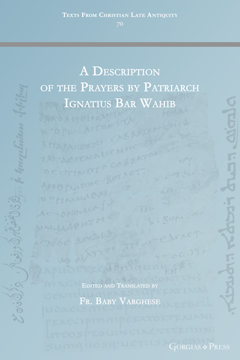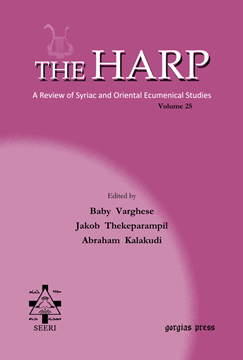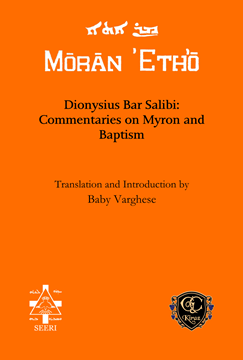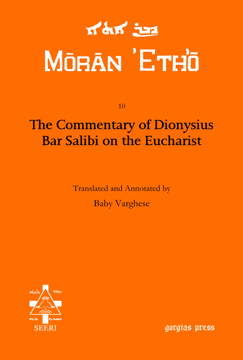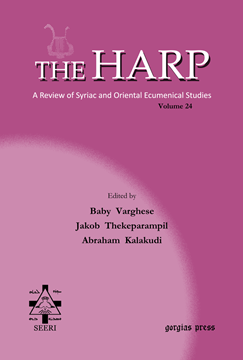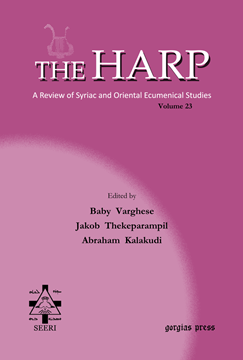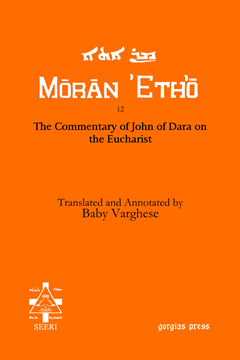Fr. Baby Varghese

Fr. Baby Varghese is a Professor at St Ephrem’s Ecumenical Research Institute (SEERI), in Kottayam, Kerala, India. He has written extensively on many areas of Syriac liturgy.
A Description of the Prayers by Patriarch Ignatius Bar Wahib
Edited and Translated by Fr. Baby Varghese
Series: Texts from Christian Late Antiquity 70
ISBN: 978-1-4632-4404-0
An edition and English translation of the "Description of the Prayers", one of the few extant works by Ignatius V Bar Wahib (Patriarch of Antioch from 1293-1333). The text has been taken from a manuscript of the Orthodox Theological Seminary, Kottayam, copied in 1915 from a manuscript of the Konat Library. The treatise offers a description of the external aspects of the canonical prayers, including washing and prostration.
$30.00 (USD)
George, Bishop of the Arabs
Homily on the Consecration of Myron
Translated by Fr. Baby Varghese
Series: Texts from Christian Late Antiquity 60
ISBN: 978-1-4632-0731-1
George was one of the last scholarly Syrian Orthodox bishops to live in the early Islamic period. His metrical homily, probably composed to be sung during the consecration of the Myron, is presented here with the vocalised Syriac text and English translation on facing pages.
$35.00 (USD) $28.00 (USD)
Commentary on Myron
Translation and Introduction by Fr. Baby Varghese
Series: Texts from Christian Late Antiquity 34
ISBN: 978-1-4632-0214-9
Moses bar Kepha: Commentary on Myron is an important witness to the history of the West Syriac Liturgy. Fr. Baby Varghese has translated the Syriac text into English for the first time.
$37.00 (USD)
The Harp (Volume 25)
Series: The Harp 25
ISBN: 978-1-61143-660-0
The Harp is the scholarly journal of Syriac, Oriental, and Ecumenical studies published by the St. Ephrem Ecumenical Research Institute (SEERI) in Kottayam, India.
$221.00 (USD)
Commentaries on Myron and Baptism
Translation and Introduction by Fr. Baby Varghese
Series: Moran Etho
ISBN: 978-1-61143-578-8
In the present work, Baby Varghese presents the Syriac text, accompanied by an English translation, of Dionysius’s commentaries on the rites of myron (anointing of oil) and baptism.
$166.00 (USD)
The Commentary of Dionysius Bar Salibi on the Eucharist
Translated and Annotated by Fr. Baby Varghese
Series: Moran Etho 10
ISBN: 978-1-61719-404-7
Bar Salibi’s commentary on the Eucharist is an invaluable witness to the history of the Syriac version of the anaphora of St James. Fr. B. Varghese provides here an English translation of the text.
$114.00 (USD)
The Harp (Volume 24)
Series: The Harp 24
ISBN: 978-1-61143-659-4
The Harp is the scholarly journal of Syriac, Oriental, and Ecumenical studies published by the St. Ephrem Ecumenical Research Institute (SEERI) in Kottayam, India.
$193.00 (USD)
The Harp (Volume 23)
Series: The Harp 23
ISBN: 978-1-61143-658-7
The Harp is the scholarly journal of Syriac, Oriental, and Ecumenical studies published by the St. Ephrem Ecumenical Research Institute (SEERI) in Kottayam, India.
$186.00 (USD)
The Commentary of John of Dara on the Eucharist
Translated and Annotated by Fr. Baby Varghese
Series: Moran Etho 12
ISBN: 978-1-4632-0033-6
Baby Varghese publishes here an English translation of the Commentary on the Eucharist by John of Dara, a ninth century leader in the West Syrian tradition. This text is an important source for understanding Eucharistic practices in the ninth century.
$46.00 (USD)
The Syriac Version of the Liturgy of St James
A brief history for Students
Series: Kiraz Liturgical Studies 47
ISBN: 978-1-60724-398-4
This is a Study which will open windows galore for Westerners, for not only is the history as recorded likely to cover ground untrodden by most English-speaking liturgists, but equally the surrounding field of study and its other scholarly occupants (who are laid heavily under contribution) will also be largely unknown.
$138.00 (USD)

